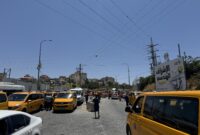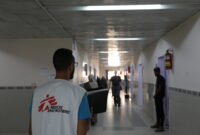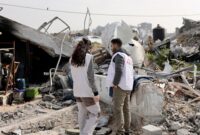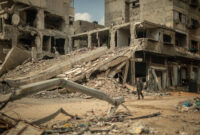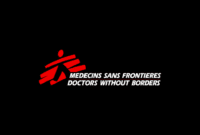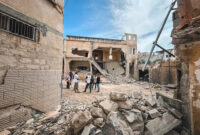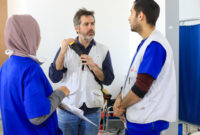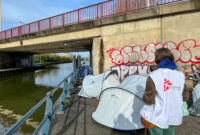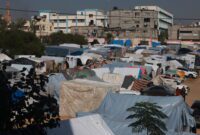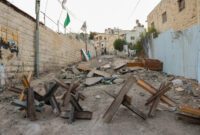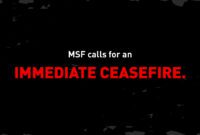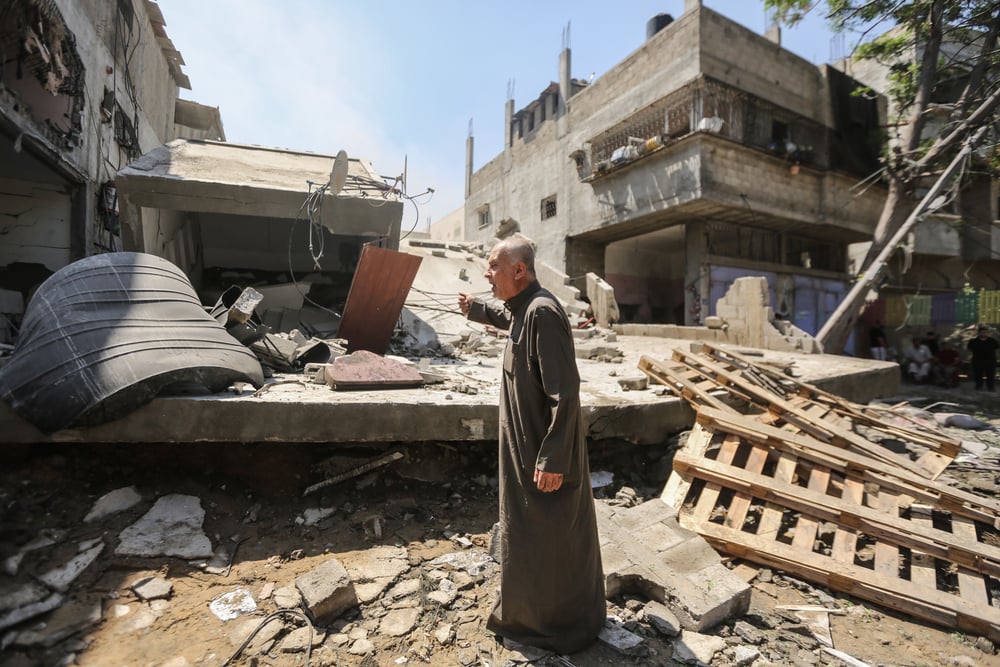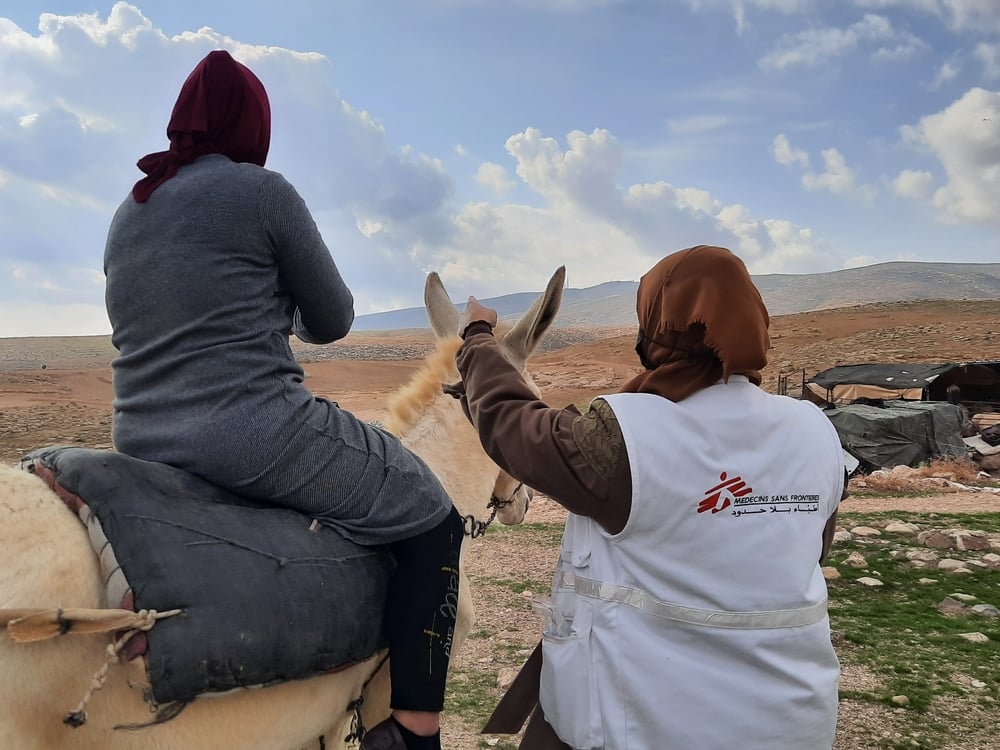No end in sight: The repeated trauma of displacement for people in Gaza
Since the horrifying war on Gaza began, at least 38,000 Palestinians, more than half of them women and children, have been killed and 87,0000 others have been injured. For those who have managed to survive the relentless onslaught of bomb blasts, shelling and gunfire, staying alive has meant moving continually from place to place with whatever basic items they can manage to carry. However, testimonies from Doctors Without Borders/Médecins Sans Frontières (MSF) staff and patients, collected over the past nine months, clearly show that nowhere is safe in Gaza.
Teams from MSF working across the Gaza Strip, endeavouring to provide essential and lifesaving care to those who have been injured by relentless Israeli attacks, have also been forced to flee for their lives.
Kamil*, MSF emergency nurse, and Haider*, MSF watchman, were part of our team treating severely injured patients at Al-Shifa hospital in Gaza City during the bombardments between October and November 2023. Between them they have been displaced 18 times up until today.
“When the war started, we carried on living at home for four days,” says Kamil. “My kids at that time were waking up and waiting for me to come and I would hold them and start calming them down and distracting them, telling them that it was fireworks, not bombing. It was very, very difficult.”
On the fifth day of the war, the top floor of Kamil’s building was hit by a drone rocket. He and his children moved into the MSF office, living alongside members of the MSF team, including Haider, whose wife and children stayed at their home, in a safer neighbourhood in north Gaza.
Kamil, Haider and the other MSF staff continued working daily at MSF’s burns clinic and Al-Shifa hospital, which was overwhelmed with patients with severe burns and shrapnel wounds.
“The patients I have seen during this war are different from previous wars,” says Kamil. “Most have deep burns, with shrapnel. Many have lost limbs or have infected wounds. I will never forget the smell of infection – it smells like bad oil.”
“We were receiving 30 to 40 patients every day at the clinic, while also working and treating dozens more at Al-Shifa hospital,” says Haider. “We kept doing this for 40 days, until things got too dangerous. The Israeli army started moving towards Al-Shifa hospital, towards us.”
By early November, at least 75 people – MSF staff and their families – were sheltering in the MSF clinic and guesthouse while fighting raged outside. “The situation was really bad, and we were all scared,” says Haider. “If we opened the door, there was fire and gunshots. They were shooting people in the street.”
Over the next few weeks, the team’s living conditions deteriorated rapidly. “In those weeks, we didn’t have enough water to clean ourselves or to drink,” says Haider. “We did not have enough to eat. Two weeks later, we were completely out of water.”
By mid-November, the situation had become untenable for our team in Gaza City, with fighting and bombing surrounding Al-Shifa hospital and the MSF clinic, office and guesthouse, and the decision was made to evacuate.
On Nov. 18, an MSF convoy set out for the south of Gaza, arranged with the approval of Israeli authorities. However, after being blocked from passing through the Israeli checkpoint on the road south, the MSF convoy was forced to turn back.
In one of the cars was Kamil and MSF nurse Alaa Al-Shawaa, with both of their families. On their way back, approximately 500 metres from the MSF clinic, they saw two Israeli tanks outside Al Shifa hospital as well as snipers on top of the surrounding buildings.
At that point, Israeli forces opened fire on the car, with Alaa sustaining a gunshot wound to the head. “The bullets came close to my forehead, and one bullet pierced Alaa’s head,” says Kamil.
“He was bent over, and his head was leaning towards the steering wheel, close to my arms, so it was difficult for me to continue driving,” says Kamil. “There was blood everywhere in the car. I was trying hard to turn right towards the MSF office and follow the first three cars, who managed to turn before they started shooting.”
Kamil and the rest of the convoy managed to escape the gunfire and reach the relative safety of the MSF clinic. After parking, they carried Alaa from the passenger seat of the car into the clinic, but they were unable to revive him.
“When I saw he was dead, I went into shock,” says Haider. “I couldn’t control myself, I couldn’t think and I collapsed on the side of the road.”
Over the following days, the MSF team and their families stayed holed up at the clinic and guesthouse. While they were there, Israeli forces arrived outside the clinic with a bulldozer, pushing the MSF convoy of cars together and burning them.
After a few more hellish days of gunfire surrounding the MSF clinic and guesthouse, a temporary ceasefire between Israel and Hamas in the Gaza Strip took effect on Nov. 24. Israeli forces retreated from the area and a coordinated convoy was once again organized with Israeli authorities to allow the MSF team and their families to move south. This time they made it.
When the MSF team arrived in south Gaza, they stayed at MSF’s Lotus shelter in the city of Khan Younis and continued working. Kamil travelled daily to the European Gaza hospital, providing trauma care to the flow of wounded patients. Haider continued to drive the medical teams to the Indonesian hospital and take care of their security.
One week later, Haider received some devastating news.
“At that time, another type of suffering began,” says Haider. “I got the news that my sister and her children were killed in Gaza City. I went into a depression. Then one of my nieces and her children were killed. Then, in the south, my nephew, his wife and his children were all killed after a bulldozer drove into their house. Twenty people from my family were killed that week. My grandmother was so sad that, soon after, she died, too. When all this happened, I was in a really dark place, but I was trying to keep working.”
On Jan. 8, around two months after Kamil and Haider arrived in south Gaza, an Israeli tank shell struck the Lotus shelter, killing the five year old daughter of an MSF staff member and wounding three other people. Following the attack, more than 125 MSF staff and their families were relocated to ACAS University in Rafah, one kilometre from the Egyptian border. They stayed there for the next two months.
“We were constantly in fear, but we had no other options,” says Haider. “There were bombings and shootings. Once they bombed a building next to us and the shrapnel hit the university. We lived like this for a while, until they announced the invasion of Rafah.”
Since the invasion of Rafah, Kamil and Haider, like thousands of other Palestinians, have essentially not stopped moving due to the incessant bombings and attacks across the South and Middle Area of Gaza.
Haider has been moving from place to place across the Al-Mawasi area, living in a tent. “I’ve been forcibly displaced eight times, an average of once a month,” he says. “Two days ago, there was another displacement. I didn’t sleep for 24 hours as we were moving from one place to another due to the explosions. I am always thinking about my wife and children in northern Gaza, and I am suffering every day.”
Living conditions are desperate for Haider and the thousands of other people on the move.
Since being forced to leave Rafah, Kamil and his children have moved multiple times in and around Al-Mawasi and Al-Bureij camp, in the Middle Area. Currently they are in Al-Bureij, but he stresses that nowhere is safe from the bombardments.
“Nowhere is safe and the conditions are terrible,” says Kamil. “We don’t have enough food, water, medicine or clothes. There are no shoes. There’s nothing. It’s very difficult to see my children like this.”
Kamil can only guess at the mental trauma suffered by his children as the result of their experiences. “It’s traumatic,” says Kamil. “Even yesterday, the kids were playing with my nephews and I heard them telling the story of Alaa, they keep telling the story of Alaa. They’re still traumatised until now.”
According to the UN, 90 per cent of Gazans have been displaced at least once since the war between Israel and Hamas began, the majority of whom are forced to live in appalling conditions. For Haider, his only wish is to be reunited with his family in Gaza City and for the bloodshed to stop.
“Enough is enough. Enough killing, enough bombing, enough shooting,” says Haider. “You can rebuild your house; you can rebuild anything. But what you can’t do is bring back people who have left us. They can never come back.”
*Names changed to protect identity.




